Punchy and flavorful, these Korean Tofu Rice Bowls are made with crispy gochujang tofu, steamed rice, spicy cucumber salad, and fermented kimchi. Vegan and Gluten Free adaptable. Video.
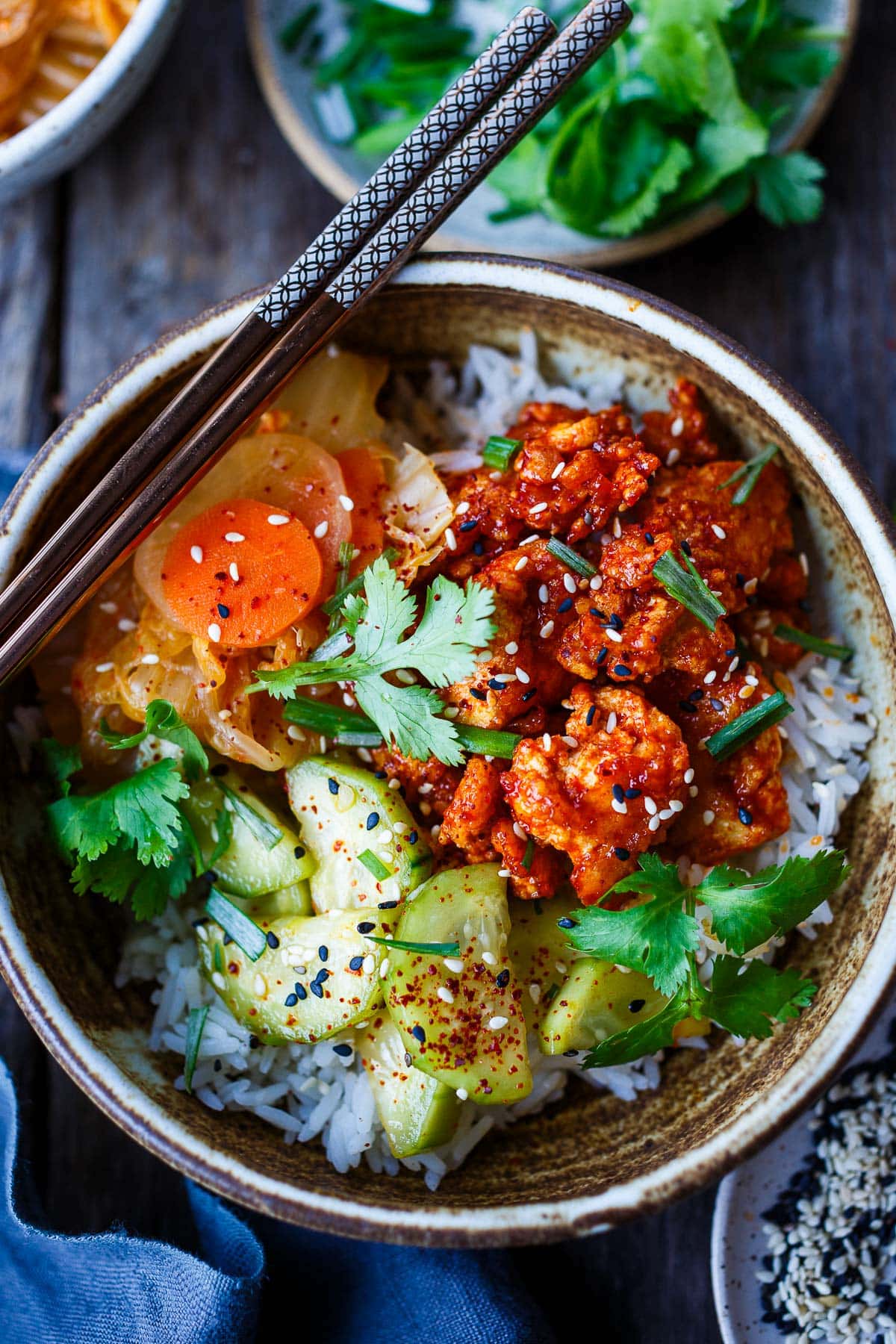
These Korean Tofu Rice Bowls are healthy and delicious! Full of plant protein, veggies, fiber, vitamins and probiotics, they are on our monthy rotation and my kids love them too!
Why You’ll Love Our Korean Tofu Bowls!
The crispy gochunang tofu is crazy good! Perfectly spicy, sweet and savory. Firm or extra-firm tofu works best for maintaining structure and absorbing flavors.
The tofu is pan-fried to a golden brown crust and mixed with a simple 3 ingredient sauce. The flavors pair perfectly with Korean cucumber salad, kimchi, and steamy rice. Add more veggies if you like!
To finish, sprinkle your Korean Tofu Bowl with sesame seeds, fresh cilantro, and an extra sprinkle of gochugaru chili flakes for an extra punch of flavor. Yum!
Korean Tofu Rice Bowl Ingredients
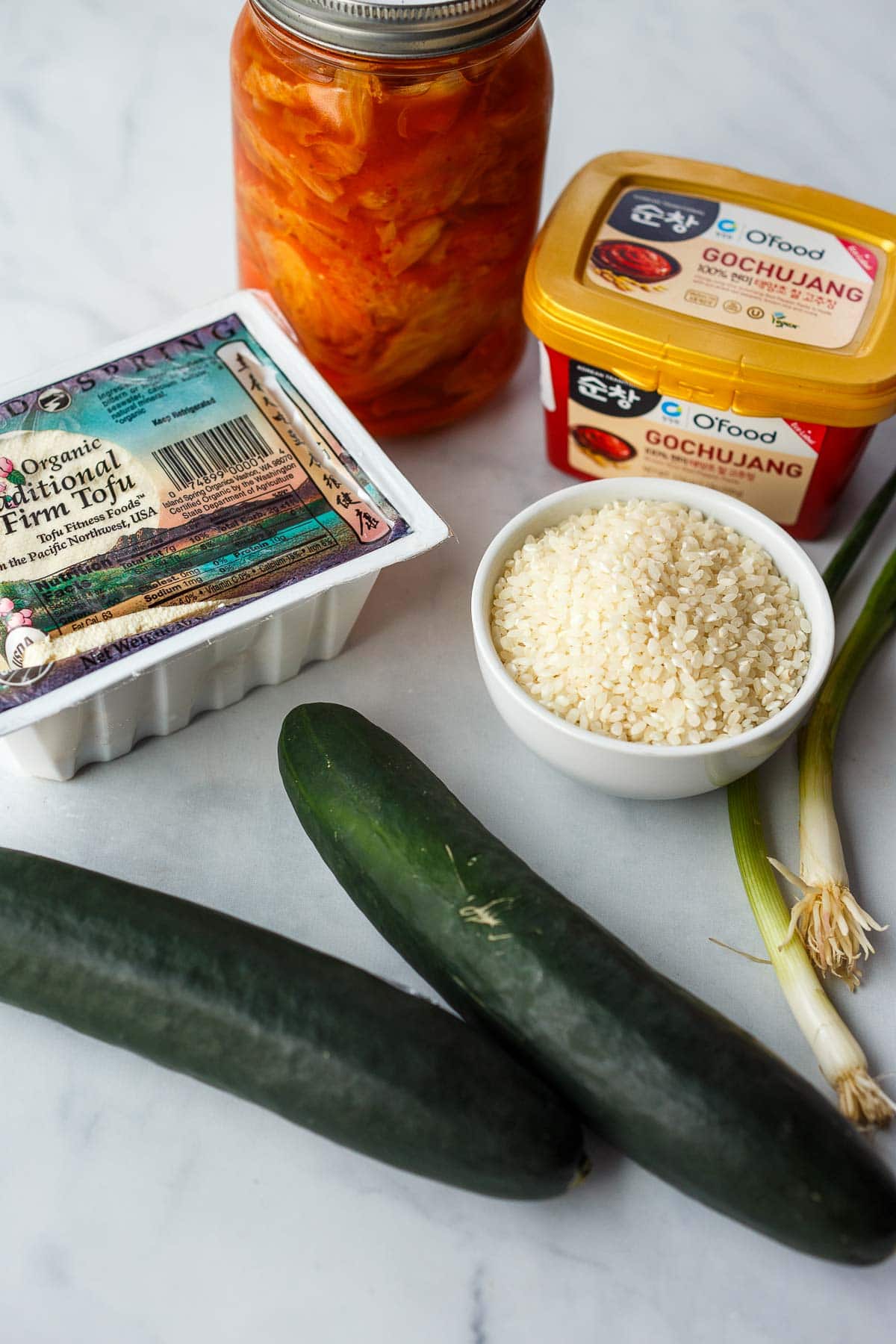
- Tofu: Use firm or extra firm tofu.
- Gochujang: Check the ingredients to ensure gluten-free if needed. Taste and adjust for spiciness. If needed, you can sub with chili garlic sauce or sriracha.
- Soy sauce: Or sub low-sodium, gluten-free tamari.
- Maple syrup
- Cornstarch: You can sub potato starch.
- Rice wine vinegar
- Sugar: Use honey or additional maple syrup.
- Toasted sesame oil
- Cucumber: English, Japanese, Armenian, or Persian. Thin-skinned and seedless is preferred.
- Scallion
- Gochugaru Korean chili pepper flakes: Spicy, but not super hot. Start small and add more as desired.
*See the recipe card below for the detailed ingredient list.
How to Make Korean Rice Bowls
Step 1: Rice. If making Jasmine rice start that now.
Step 2: Prep the Tofu: Using your hands, break tofu apart into roughly one-inch pieces. (The ragged edges help crisp up the tofu and soak up more sauce, if you prefer cubes go for it!) Place a clean dish towel or paper towel on a plate and spread tofu out in one layer on the towel to absorb excess moisture.
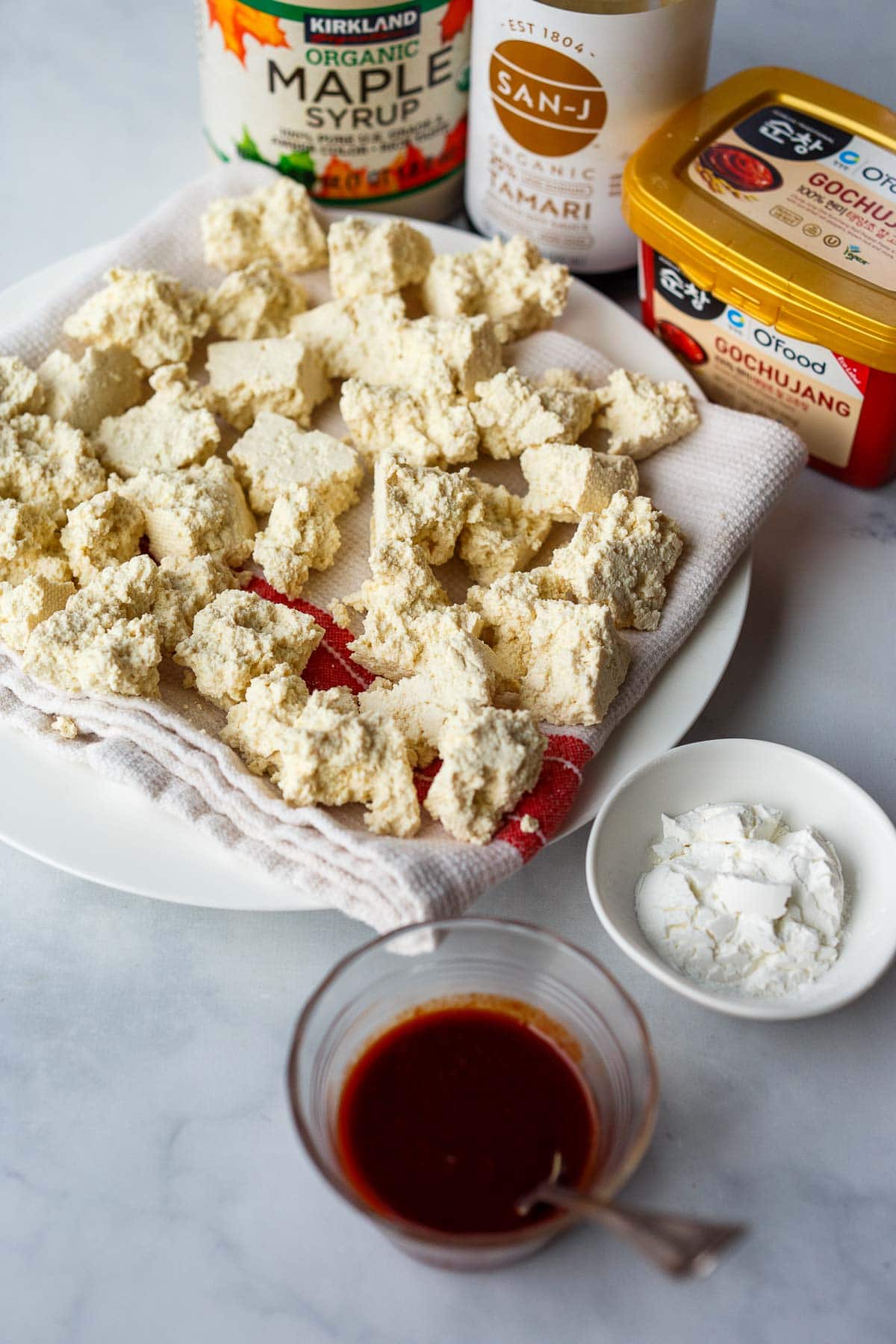
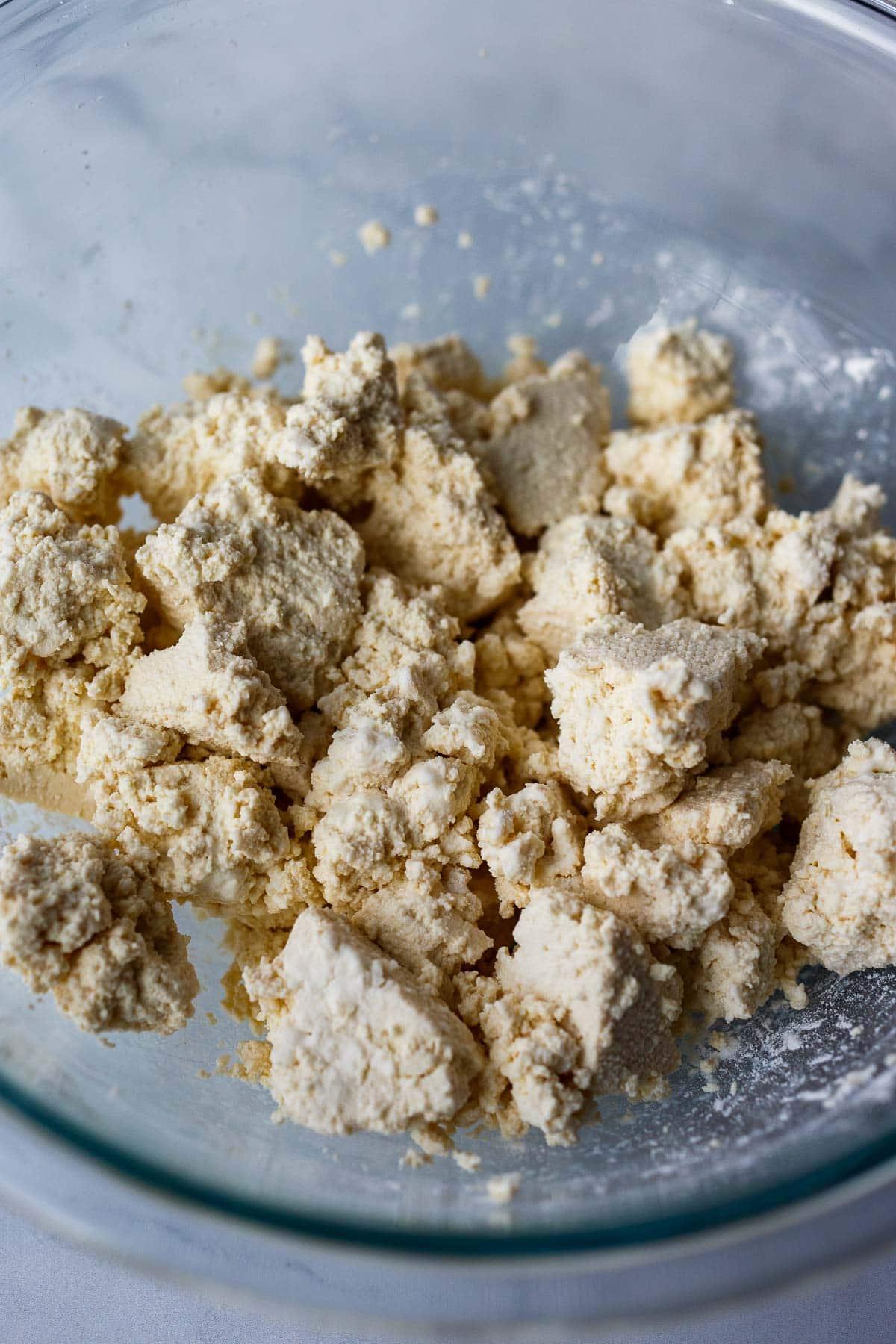
Step 3: Make the sauce. In a small bowl mix together gochujang paste, soy sauce, and maple syrup. Set aside.
Step 4: Make the Crispy Gochujan Tofu. Remove the towel from the tofu and season with salt and pepper. Sprinkle with cornstarch (or potato starch) and toss to coat evenly.
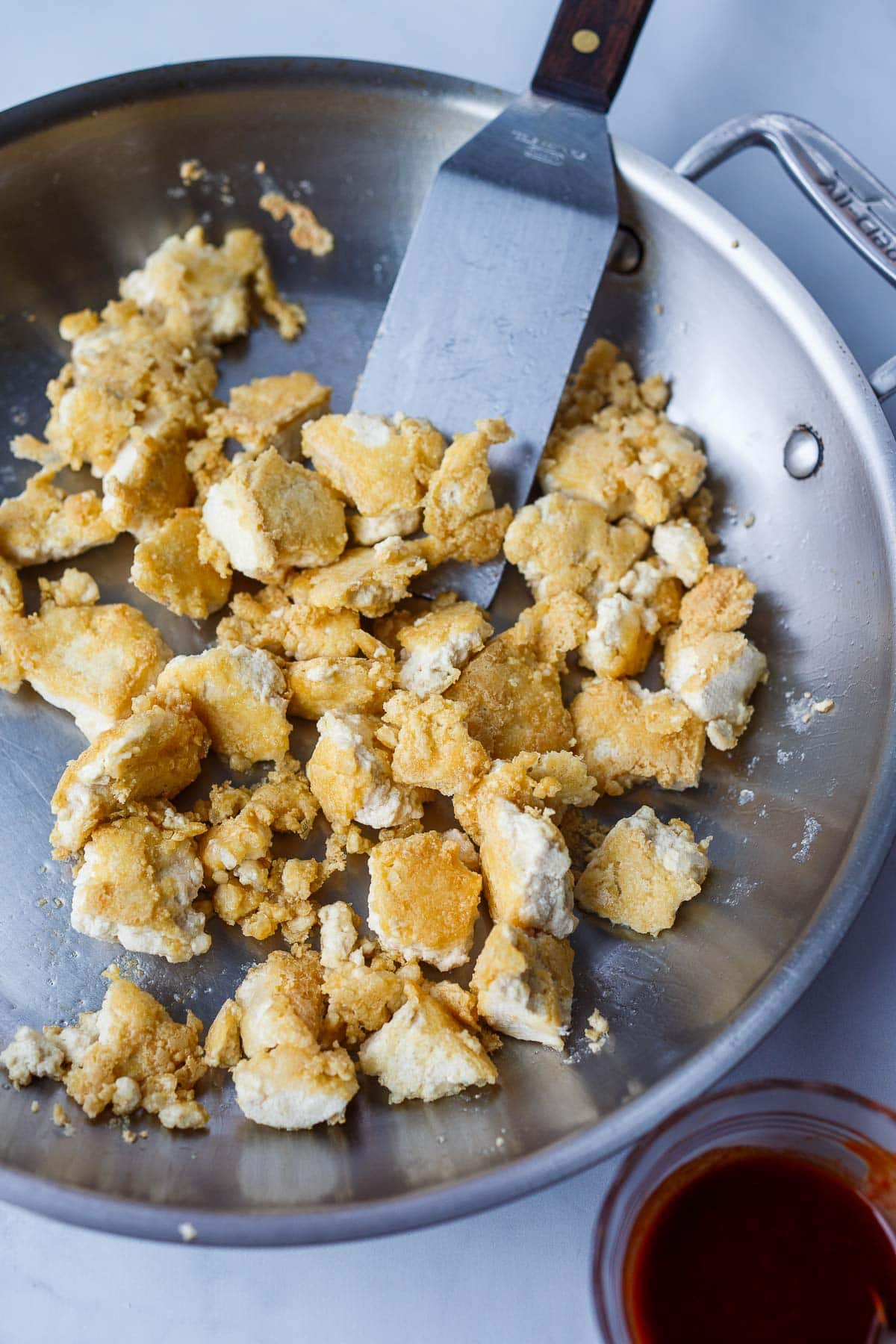
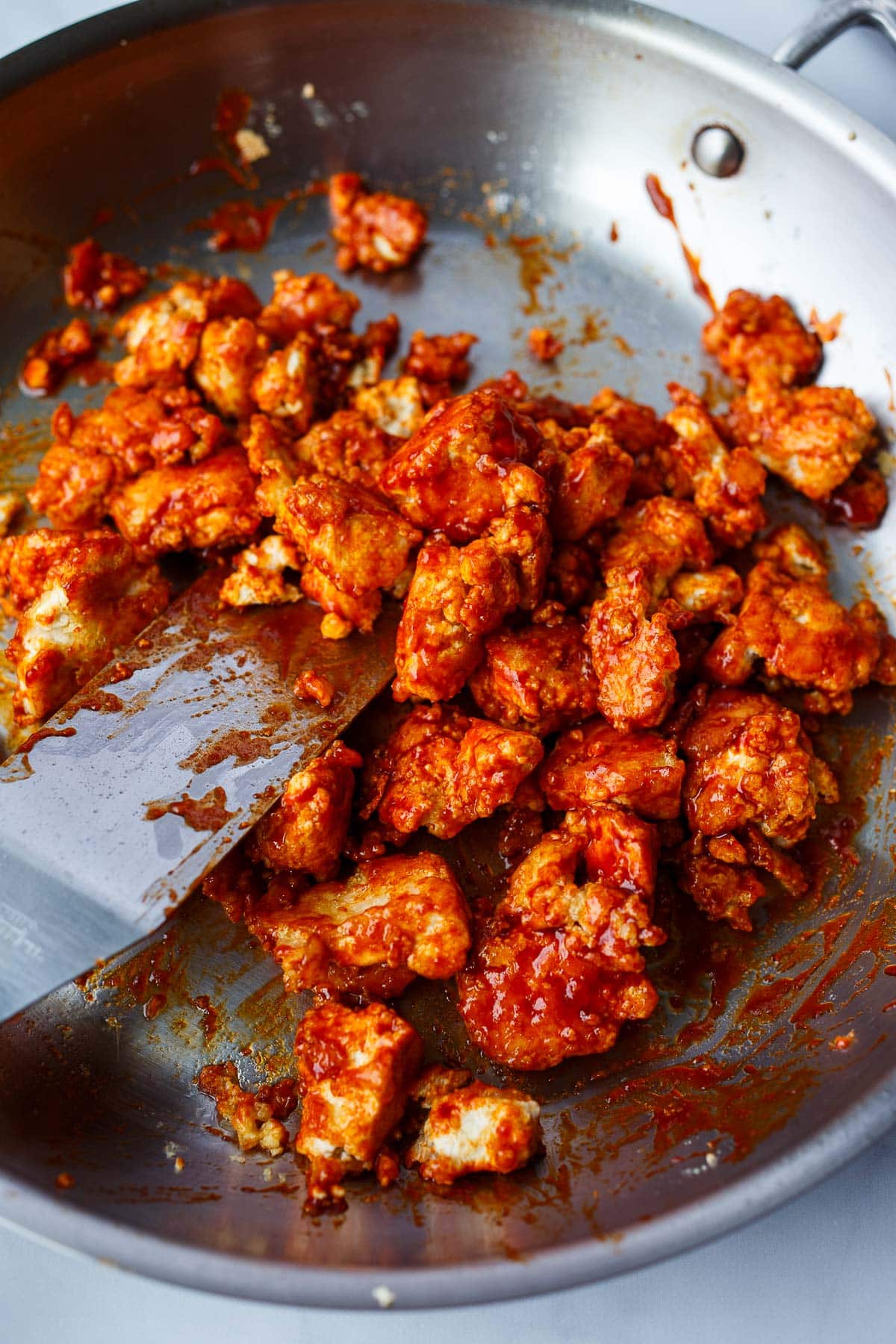
Heat up a skillet to medium-high heat, add 1-2 tablespoons oil to coat the pan. Fry the tofu in one layer: put it in the pan and leave it for about 5 minutes (don’t try to move it!) over medium heat until it develops a crust and naturally releases. Use a spatula to flip the pieces over and cook another 4-5 minutes. Stir the pieces around to get the sides of the tofu.
Stir in the gochujang sauce, you can do this in a separate bowl or directly in the pan. Turn off the heat and set aside.
Step 5: Make the Korean Cucumber Salad (do this ahead!). In a colander, toss cucumbers with 1 teaspoon of salt and set over a plate for 30 minutes. (See notes for skipping this step).
In a bowl whisk together the soy sauce, rice vinegar, honey, sesame oil, scallions and Gochogaru flakes.
Lightly rinse the cucumber slices and use a kitchen towel to blot and dry. With the cucumbers in a bowl, add 1/2 of the dressing to the bowl and mix. Reserve the remaining dressing to add to the bowls if they need extra sauce for the rice.
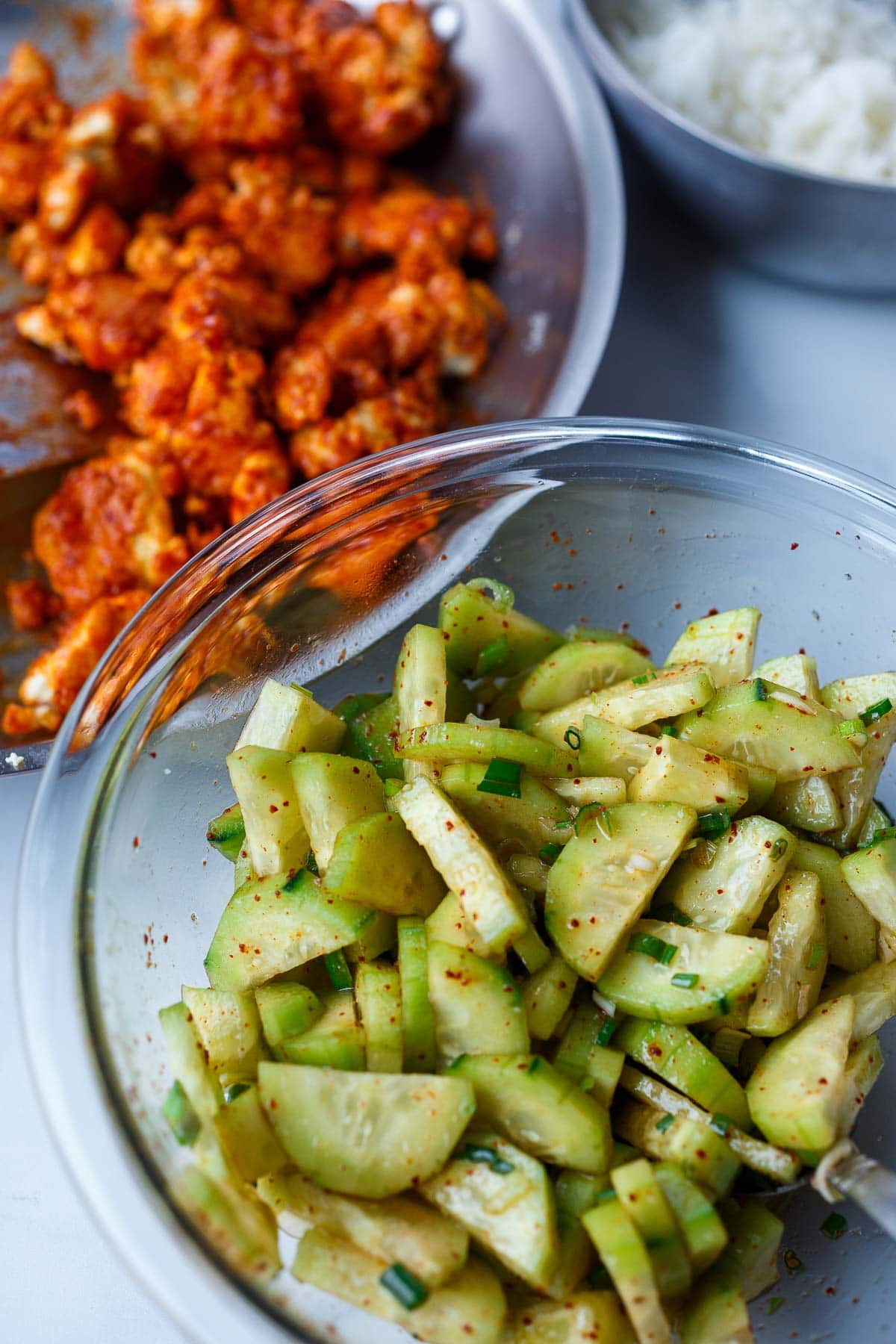
Step 6: Assemble the bowls. Spoon the warm rice into bowls, top with crispy Korean Tofu and the Korean cucumber salad. Add kimchi, toasted sesame seeds and fresh cilantro. Serve with extra dressing.
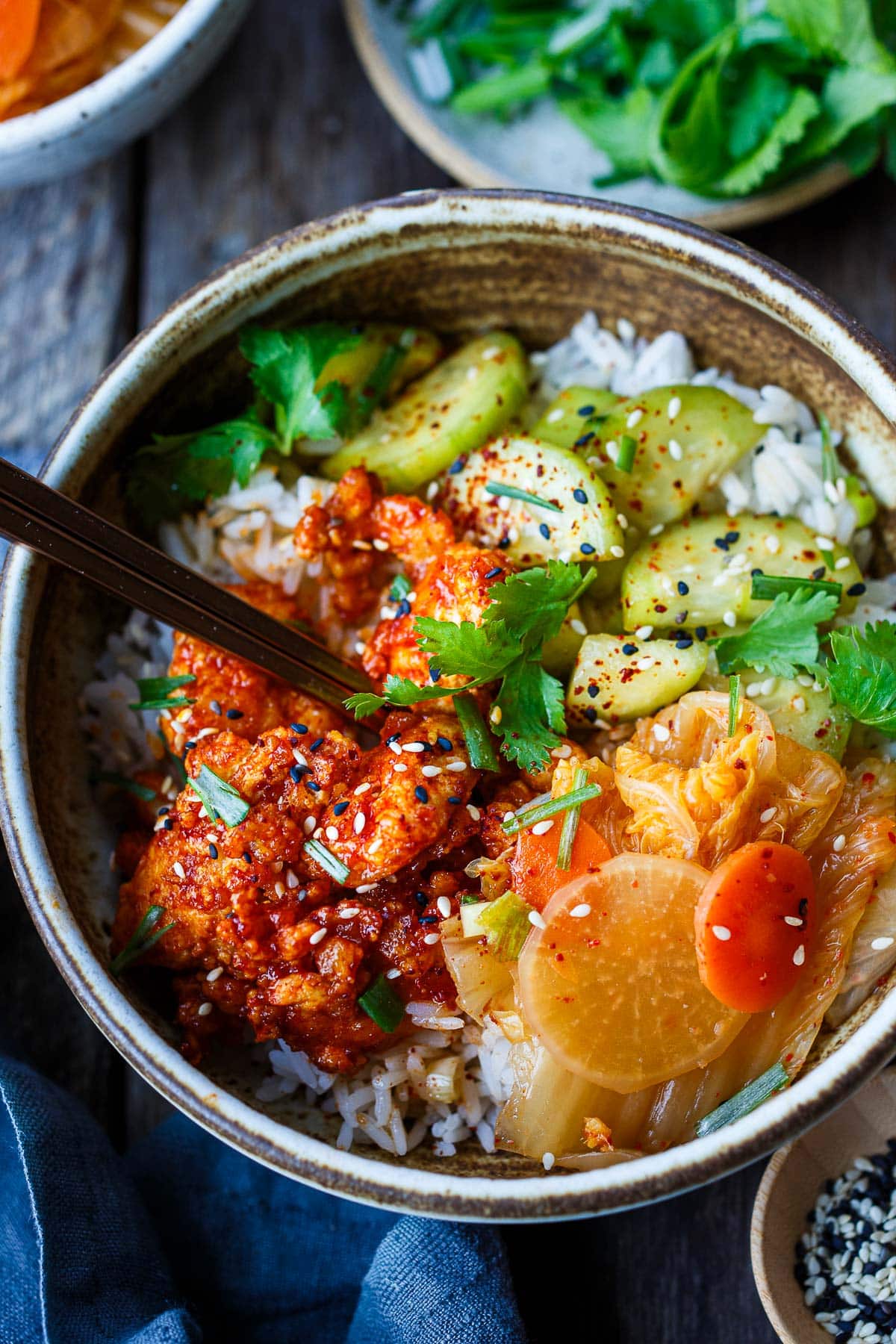
Expert Tips
- Use firm tofu: Firm or extra firm tofu works best to maintain structure, absorb flavor, and achieve a crispy texture. Make a double batch!
- Load it up with veggies: Get creative here and add any vegetables or toppings you’d like! Shaved carrots, shredded cabbage, diced avocado, or steamed broccoli are all great options.
- Save time: If you need to make this a quicker meal, you can skip salting the cucumbers. This step makes the cucumbers less watery and more crisp, but it is delicious either way.
Korean Tofu Serving Suggestions
Here are some ideas of vegetables and toppings you can serve in this Korean Tofu Bowl:
- Jasmine rice: provides a lovely base for the bowl. Use whatever rice is your preference.
- Kimchi: Full of gut-supporting probiotics, make your own kimchi, or use store-bought!
- Raw veggies: avocado slices, shaved carrot, shredded cabbage, sprouts
- Stir-fried veggies: broccoli, cauliflower, carrots, mushrooms, pea pods, green beans, bell peppers, spinach
- Garnishes: toasted sesame seeds, fresh cilantro, gochugaru chili flakes, lime wedges, pickled ginger
FAQs
Pressing the tofu firmly with a paper towel can help remove excess moisture, however, this step is not always necessary. Do it if your tofu seems really wet but just for a few minutes. The tofu can become too dry and crumbly when pressed too long. Here we skipped the pressing and just lay the tofu out on a clean towel to absorb excess moisture.
The secret here is not to move the tofu once you add it to the pan! Let it cook for 5 minutes, and then the tofu should have a crust and naturally release from the pan.
In addition to being a great source of protein, tofu has essential amino acids, minerals, and vitamins, including calcium, manganese, iron, and vitamin A.
Korean tofu is best when served immediately to retain crispiness. However, you can store leftovers in the fridge for up to 4 days. To reheat the tofu, simply warm in a sauté pan or in the air fryer.
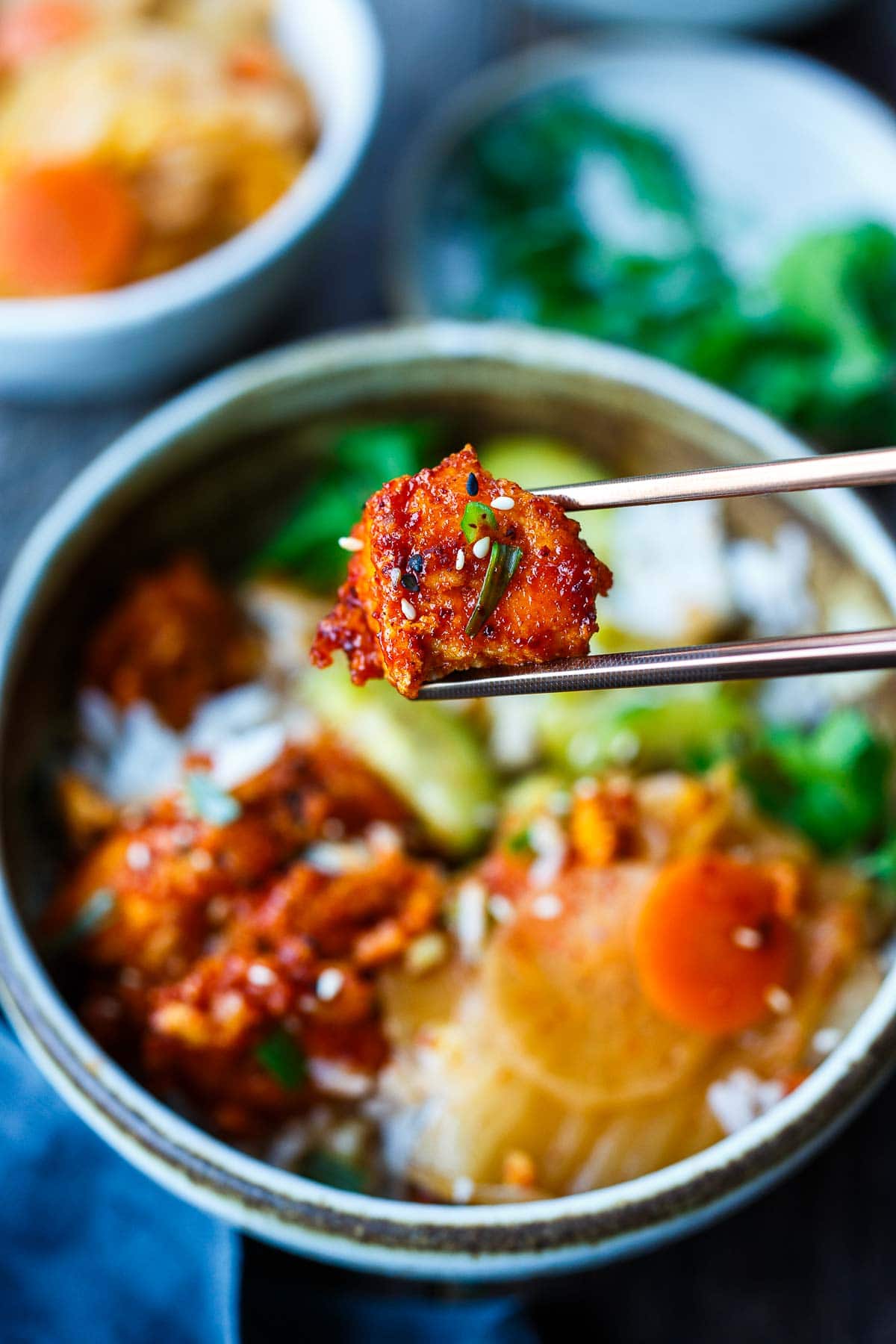
Hope you enjoy this Korean Tofu Bowl! Let us know what you think!
More Korean Recipes You May Enjoy!
Korean Tofu Rice Bowls Video
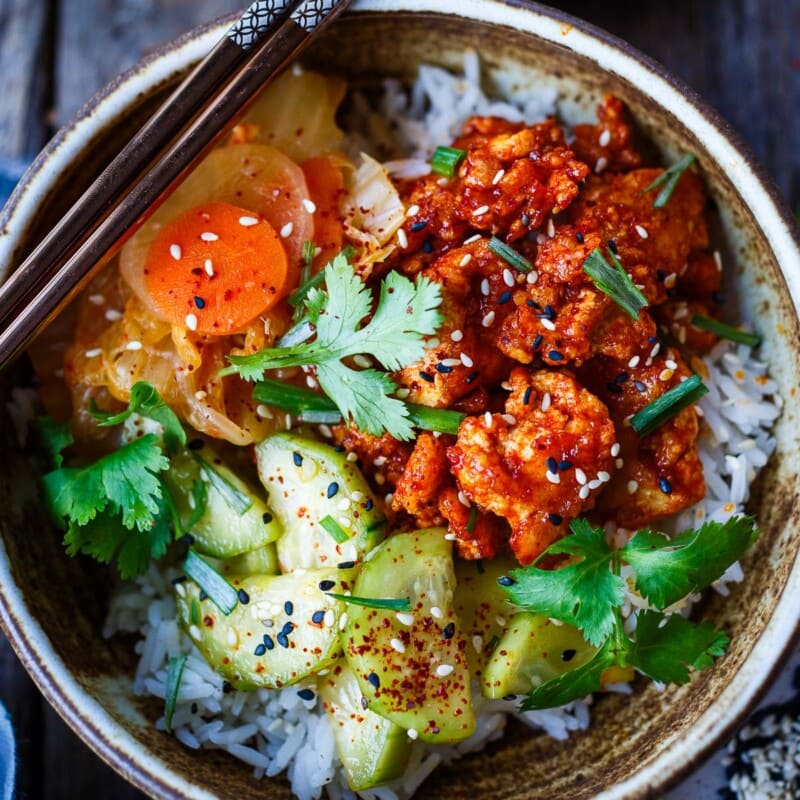
Korean Tofu Rice Bowl
- Prep Time: 20 minutes
- Cook Time: 20 minutes
- Total Time: 40 minutes
- Yield: 4 servings
- Category: bowl, dinner idea
- Method: stovetop
- Cuisine: korean
- Diet: Vegan
Description
Crispy Korean Tofu Bowls are made with crispy gochujang tofu, spicy cucumber salad and kimchi. Easy and full of flavor! Vegan and gluten-free.
Ingredients
2-3 cups cooked rice (we used jasmine rice) (½ cup -¾ cup per serving)
Crispy Korean Tofu
- 8 ounces of firm tofu (extra-firm tofu works too)
- 3 tablespoons cornstarch or potato starch
- 1–2 tablespoons gochujang – taste your gochujang for spiciness and adjust accordingly (see notes on replacements) **Check the ingredients to ensure gluten-free if needed.
- 1 tablespoon soy sauce or low-sodium gf tamari
- 1 tablespoon maple syrup
Korean Cucumber Salad (Oi Muchim)
- 1 teaspoon salt
- 1 teaspoon soy sauce or low-sodium gf tamari
- 3 tablespoons rice wine vinegar
- 1 tablespoon sugar (honey or maple)
- 1 tablespoon toasted sesame oil
- 2 cups cucumber, sliced into thick rounds or 1/2 moons (English cucumber, Japanese, Armenian, or Persian- thin-skinned, seedless is preferred)
- 1 scallion, sliced thin
- 1/2– 1 teaspoon Gochugaru Korean chili pepper flakes (spicy but not super hot, start with less and add more to taste)
Optional serving suggestions
- Jasmine rice
- Kimchi
- Raw veggies: avocado slices, shaved carrot, shredded cabbage, sprouts
- Stir-fried veggies like: broccoli, cauliflower, carrots, mushrooms, pea pods, green beans, bell peppers or spinach
- Garnishes: toasted sesame seeds, fresh cilantro, gochugaru chili flakes
Instructions
- If making rice start that now.
- Make the Crispy Korean Tofu Using your hands, break tofu apart into roughly one-inch pieces. (The ragged edges help crisp up the tofu and soak up more sauce, if you prefer cubes go for it!) Place a clean dish towel or paper towel on a plate and spread tofu out in one layer on the towel to absorb excess moisture.
- In a small bowl mix together gochujang paste, soy sauce, and maple syrup. Set aside.
- Remove the towel from the tofu and season with salt and pepper. Sprinkle with cornstarch (or potato starch) and toss to coat evenly.
- Heat up a skillet to medium-high heat, add 1-2 tablespoons oil to coat the pan. Fry the tofu in one layer: put it in the pan and leave it for about 5 minutes (don’t try to move it!) over medium heat until it develops a crust and naturally releases. Flip the pieces over and cook another 4-5 minutes. Stir the pieces around to get the sides of the tofu. Stir in the gochujang sauce, you can do this in a separate bowl or directly in the pan. Turn off the heat and set aside.
- Make the Korean Cucumber Salad In a colander, toss cucumbers with 1 teaspoon of salt and set over a plate for 30 minutes. (See notes for skipping this step).
- In a bowl whisk together the soy sauce, rice vinegar, honey, sesame oil, scallions and Gochogaru flakes.
- Lightly rinse the cucumber slices and use a kitchen towel to blot and dry. Add 1/2 of the to the dressing in the bowl and mix. Reserve the remaining dressing to add to the bowls if they need extra sauce for the rice.
Assemble
- Place rice in bowls, top with Korean tofu and Korean cucumber salad.
- Add kimchi, toasted sesame seeds and fresh cilantro.
- Serve with extra dressing.
Notes
Try to find gochujang paste, it really makes the tofu special, but if it is not available you can use garlic chili sauce or sriracha and adjust to your spice level preference!
The Korean tofu is at its best served immediately. But you can store leftovers in the fridge and reheat in a saute pan or bake in the air fryer.
If short on time, you can skip the salting the cucumbers step- it is delicious either way, salting releases water from the cucumbers making the salad less watery and giving the the cucumbers a crisp texture.
Nutrition
- Serving Size:
- Calories: 310
- Sugar: 8.1 g
- Sodium: 424.2 mg
- Fat: 8.9 g
- Saturated Fat: 1.3 g
- Carbohydrates: 44.3 g
- Fiber: 1.9 g
- Protein: 12.8 g
- Cholesterol: 0 mg
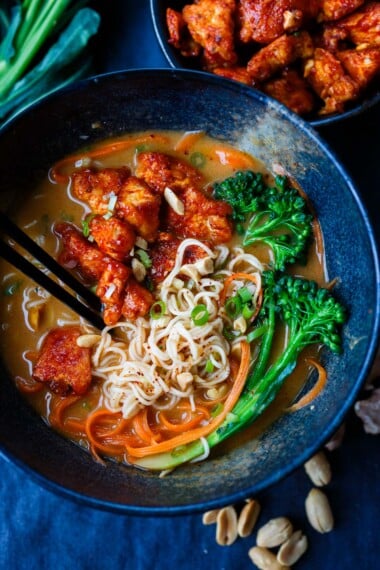
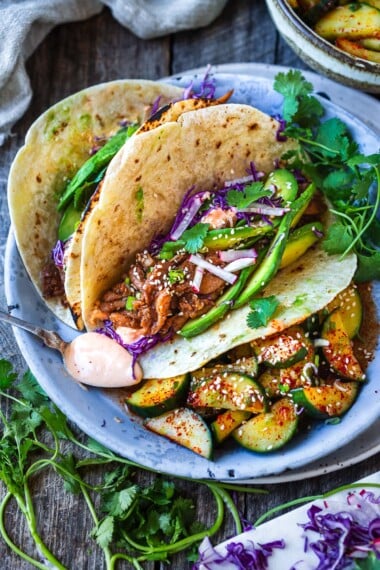
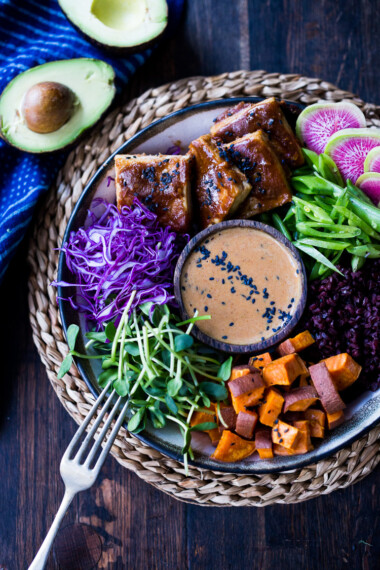
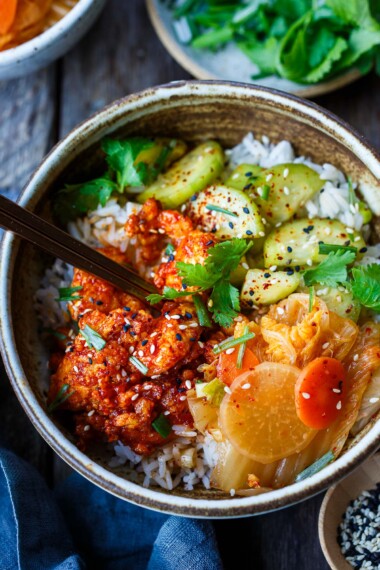
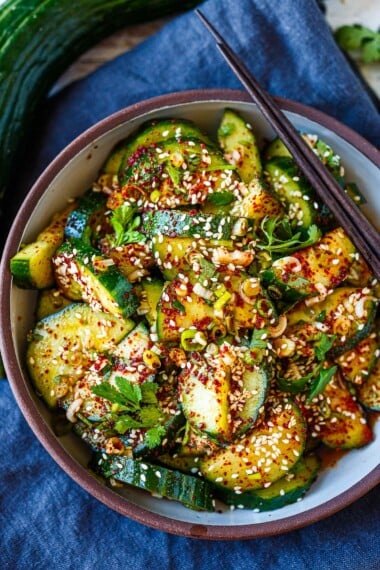
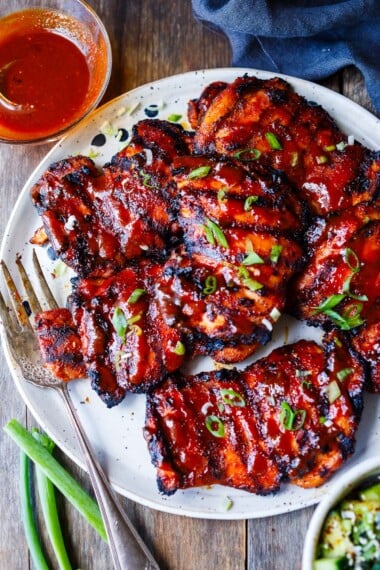
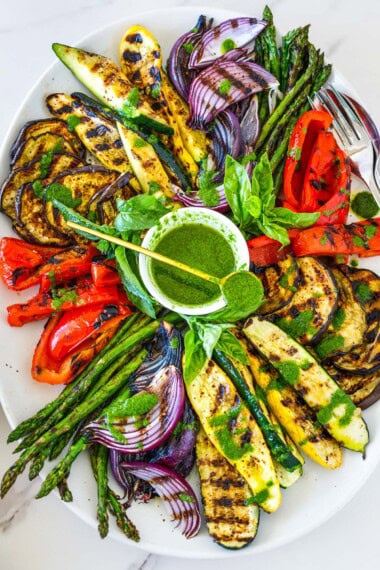



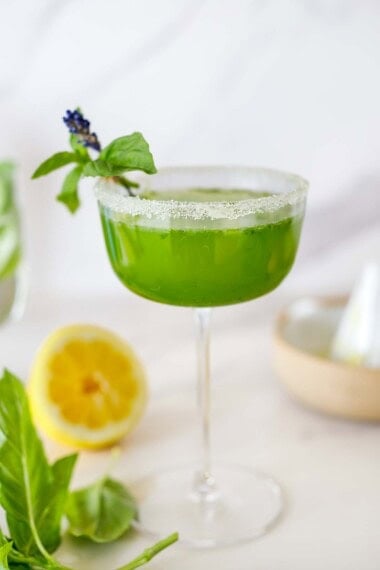
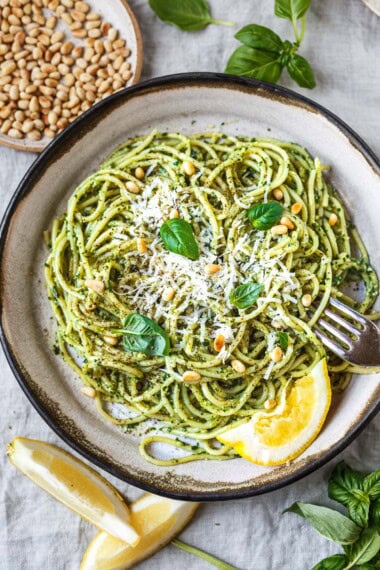
Made this tonight and it is by far the best tofu I’ve ever eaten. Normally I’m all about the veg but all I wanted was to eat two bowls of this perfect tofu and rice. Soooo good.
Love hearing this Kathryn!
This is my new go-to method for making tofu! Excellent recipe.
Glad you gave it a go!
It was a delicious meal. Full of flavor. I’ll make it again.
I didn’t have the Korean pepper flakes so I substituted Mexican red pepper flakes.
Starting to move away from meat. Incorporating more of your vegetarian recipes into our weekly meal plan. This far, I haven’t made one we haven’t liked.
So glad you liked this Lelia. Great to hear you are enjoying the recipes!
This was so delicious and easy! I love the torn pieces of tofu. I sent the recipe to a friend any my son and they loved it as well. Thanks for another great recipe!
Great to hear Gina, thanks for sharing!
This was so delicious I made it 2 days in a row! Looking forward to eating it again soon. I freeze and thaw my tofu and then really take the time to press all the water out. Tearing it rather than cutting into chunks was a game changer. The second time I made it I just served the tofu with brown rice and steamed broccoli and that was perfect- so quick and easy and incredibly tasty. Thank you for yet another fantastic recipe.
Awesome Rachel! So glad you are enjoying it. I will have to try freezing it, I bet it really absorbs the sauce.
Absolutely delicious! Great combo of flavors and really quick and easy. Made it twice now, fast enough for a weeknight dinner. The cucumber marinade is delectable!
Yay, so happy you are enjoying!
Delicious and easy to make-thank you!
So glad you liked these!
Hi! Just wondering if the tofu can be baked instead of pan frying?
I haven’t tried but it should work! Let us know if you try it.
Delicious week night meal and now on regular rotation in our home – thank you!
Awesome, so glad you are enjoying Danielle!
We are obsessed with this tofu in my household. I first tried it in the peanut butter ramen (which is excellent) but we really like these bowls. Everyone can customize. It’s my 13yo son’s favorite meal. He asks for it at least twice a week and devours it. I have to double or triple the recipe if I want any!! Highly recommend!
So happy you all are enjoying Kristin!
Really good.
Super good. I followed recipe exactly. My partner said it’s some of the best tofu he’s ever had. I served with kimchi and stir-fried broccoli. I always like your recipes, thank you!
So glad you both enjoyed!
Delicious and so easy to make! I decided to make it twice in a row.
Awesome Cee, so happy you enjoyed!
This Korean tofu recipe never fails! Good with everything
Thanks Liz 🙂
Gochujang can contain wheat so be careful saying it’s gluten free. Signed Korean American mom of kid with celiac
Thanks Judy, I will make a note!
I’m not sure why you would use Jasmine rice. You can’t call it Korean and use that. This is basically a vegan bibimbap—kind of. The sauce you used on the tubu is basically bibimbap sauce. And no Korean dish would substitute gochujang with sriracha or any other “spicy” ingredient because gochujang is unique in its flavor. Substituting changes the entire taste of the dish! Idk why everyone thinks they have to call their recipes Korean because you use a few Korean ingredients.
Hi UmmaLee, I see your point. Our goal here is to make the recipes accessible and adaptable to everyone using what ingredients they may have on hand. 🙂